Preprints are manuscripts that often look like journal papers but have not been peer reviewed and are not formatted to a particular journal’s style. They are the “author’s version” of the paper (before any improvements are made via peer review, journal copyediting, etc.). Preprints do not imply that the work described is of low quality.
Preprints can be posted on an open-access platform (e.g., a preprint server or other public repository) or on an institutional or personal website. Platforms and repositories often focus on specific fields of study. For example, the oldest and probably best-known preprint server is aRxiv (pronounced “archive”), which hosts preprints in physics, mathematics, and computer science, among other fields. Although preprints are not peer-reviewed, they may be screened or moderated to prevent inappropriate content from being posted on platforms or in repositories.
Preprint servers enable readers to post feedback about preprints they are interested in, which allows the authors to develop their research and improve their manuscripts before submitting the work to a journal. Not all preprints are later published in journals, but many are.
Authors can update their preprints at any time before journal submission, and they should decide whether or not they want any new updates they post to be automatically logged and time-stamped. Although the details will differ among preprint servers, timestamps are simply a record of when different versions of a work were posted. Many preprint servers offer the automated process of version control, which includes assigning timestamps and giving access to older versions of the preprint.
Preprints often have a digital object identifier (DOI) assigned, which makes them a permanent record of the scientific work. The DOI enables the preprint to be cited clearly by other researchers, to be connected later to a fully developed journal paper, and to be listed in a CV/resume if a final journal paper is not published or until one is published. If authors later find a problem with the content of their preprint, the DOI means that the preprint cannot be fully deleted from the public record. However, the authors can formally apply to withdraw the preprint, which removes the content but retains metadata such as the authors’ names, preprint title, and DOI. The preprint is marked as “Withdrawn” and the reason for the withdrawal is posted (see examples of formal withdrawal processes for preprints here and here). Withdrawing a preprint is like retracting a published paper, so authors need to take care to avoid this whenever possible. Also, copies of the original preprint may continue to be available via general search engines.
Like manuscripts submitted to journals, preprints should follow best publication practices, specifically ethical requirements such as those regarding informed consent, participant anonymity, plagiarism/text overlap, and permissions for reuse of images. All authors must agree to each version of the preprint to be posted.
Authors should consider the license under which they publish their preprint (e.g., Creative Commons CC0 or CC BY). For example, the publisher Wiley states that authors should retain copyrights to their work when posting to a preprint server and preferably assign a “no re-use” licence. ASAPbio provides a clear licensing diagram that explains what rights and permissions are conferred by the different Creative Commons licenses and no license at all. These licenses affect how the preprint can be shared and reused by others.
Historically, authors in some fields faced barriers to posting preprints. For example, the preprint policy of Nature has moved from opposition, to tolerance, and now to active encouragement. In the past, many journals considered a preprint to be prior publication and would not accept it as a submitted paper. Now, more journals and academic publishers have come to accept and promote preprints, particularly as open science has gained ground. Some journals and publishers even allow the direct transfer of preprints from a preprint server to their journals, making submission of a final preprint version to the journal easy. However, not all journals and publishers allow preprints, so always check your target journal’s instructions for authors before posting a preprint.



